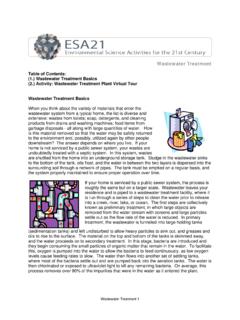Transcription of Trees and Carbon - Kennesaw State University
1 Trees and Carbon Table of Contents: (1.) Introduction (2.) Carbon Cycle and Global Warming (3.) Carbon Sequestering in Trees (4.) Allometry (5.) Forest Data: Carbon Analysis (6.) Activity Introduction To understand the environment, it is important to understand how organisms and their surroundings interact. Since all organisms use energy, we need to understand how energy can be used and transferred. Because all organisms are made of substances, it is equally important that we understand how chemicals are used and transported through an ecosystem. This exercise will help contribute to our understanding of the movements of compounds in ecosystems.
2 The transport and transformation of substances in the environment are known collectively as biogeochemical cycles. These global cycles involve the circulation of elements and nutrients that sustain both the biological and physical aspects of the environment. For example, all known organisms on this planet depend on water to sustain them. They are constantly cycling water, consuming it on a regular basis either by itself or with nutrients, while expelling water (with waste products) at the same time. Besides being critical for the biosphere, water is also an extremely important part of the physical environment.
3 When water vapor condenses to form clouds, more of the Sun's rays are reflected back into the atmosphere, usually cooling the climate. Conversely, water vapor is also an important greenhouse gas in the atmosphere, trapping heat in the infrared part of the spectrum in the lower atmosphere. Water is also involved in other biogeochemical cycles. The hydrologic cycle intersects with almost every other element cycles, as well as some of the geological cycles such as the sedimentary cycle. Carbon Cycle: Example In this and other activities, we are going to study how Carbon cycles through our ecosystem and how mankind affects this cycle.
4 It is important that we understand how Carbon cycles through the ecosystem for two reasons. The first of these reasons is that all organic material contains Carbon . From the smallest vitamin molecule all the way up to the long polymer chains of proteins and DNA, Carbon provides the basis of all organic compounds. The second reason why we need to understand the Carbon cycle is because of its effect on the physical environment. Carbon , in the form of Carbon dioxide, is released as a waste product of oxidation. This means that it is released during the combustion of fossil fuels, as well as the respiration of organisms.
5 As we will see later, this can have a tremendous effect on our climate, since Carbon dioxide is a greenhouse gas. Carbon has two phases in the Carbon cycle: gaseous and solid. Its gaseous phase is mostly in the form of Carbon dioxide, but it can also be found in compounds like methane and Carbon monoxide. Carbon dioxide can be taken out of the atmosphere by photosynthesis in plants, which convert the Carbon into a solid form (sugars) that can be stored or put back into the air during respiration. It can also be removed from the atmosphere by being absorbed by water, where it becomes available to water plants for photosynthesis as well as being available to form compounds such as calcium carbonate (chalk) or to be put back into the atmosphere when the water gets warmer.
6 As we can see, the Carbon cycle has reservoirs where it is stored as a solid. The diagram below shows some of these. In a cycle that has reached equilibrium, the rate at which Carbon is removed from storage is equal to the amount that is being taken out of the atmosphere. The reason why many people are concerned about the Carbon cycle is because mankind's intervention has caused this system to go grossly out of equilibrium. By burning fossil fuels, mankind has upset the balance of the cycle and greatly increased the rate at which Carbon is returning to the gaseous phase.
7 Is this a problem? In order to understand why it might be a problem, we need to understand more about the properties of Carbon dioxide. Greenhouse Effect Global Warming The effect of infrared re-radiation being absorbed in the atmosphere is called the "Greenhouse Effect" since it mimics what happens in a real greenhouse. There, the radiation is trapped by glass window panes, which are optically opaque in the infrared region of the spectrum. Since the infrared radiation does not pass through the glass, it remains in the greenhouse and keeps the inside temperature warmer than the outside temperature (the same effect keeps the inside of your car warm even on a cold sunny day).
8 The science behind this effect in the atmosphere is fairly well understood. Certain gases, such as water vapor, Carbon dioxide, and methane, are able to absorb infrared radiation very well. The Earth re-radiates absorbed sunlight back into outer space mostly in the infrared range of the electromagnetic spectrum. When these gases are present in the atmosphere, they will absorb this energy before it gets back into space, and thereby heat the atmosphere. We see this in action everyday, both on our planet and on others in the Solar System. For example, Venus has an atmosphere that contains almost a million times the concentration of Carbon dioxide (a greenhouse gas) as our atmosphere.
9 If Venus were to have no atmosphere, its average temperature would be about 230 K (-45o F); because of this Carbon dioxide concentration (plus a small amount of other greenhouse gases), it has a temperature of 740 K (about 900oF). A similar, but smaller, effect is seen on Mars and other planets that contain greenhouse gases. Without the greenhouse gases that we have on Earth, it is estimated that our average daily temperature would be about -10o F, instead of the 60 of that it is. While water vapor has the greatest contribution to atmospheric heating due to the greenhouse effect here on Earth, most of the attention in this area lately has been focused on Carbon dioxide.
10 The reason for this is that the levels of Carbon dioxide have increased from about 292 ppm (parts per million) to over 400 PPM over the last 100 years. This increase in concentrations has corresponded to the same time period over which we have seen the average tropospheric temperature increase about 1o C. The correlation between these two events, plus our knowledge of how greenhouse gases work, has led many to hypothesize that the Earth will continue to get warmer as we release more and more greenhouse gases into the atmosphere. Carbon Sequestering in Trees Carbon Reservoirs In burning fossil fuels as an energy source, we are taking stored Carbon and putting it back into the atmosphere at a rate that is greater than it is being taken out.








